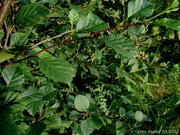Alder
|
|
- For other uses, see Alder (disambiguation).
| Alder | ||||||||||||
|---|---|---|---|---|---|---|---|---|---|---|---|---|
| Missing image Tagalder8139.jpg Alnus serrulata (Tag Alder) Male catkins on right, mature female catkins left Johnsonville, South Carolina | ||||||||||||
| Scientific classification | ||||||||||||
| ||||||||||||
| Species | ||||||||||||
|
About 20-30 species, see text. |
Alder is the common name of a genus of flowering plants (Alnus) belonging to the birch family (Family Betulaceae). The genus comprises about 30 species of monoecious trees and shrubs, few reaching large size, distributed throughout the North Temperate zone, and in the New World also along the Andes southwards to Chile. The leaves are deciduous (evergreen or nearly so in a few species), alternate, simple, and serrated. The flowers are catkins with elongate male catkins on the same plant as shorter female catkins, often before leaves appear; they are mainly wind-pollinated, but also visited by bees to a small extent. They differ from the birches (Betula, the other genus in the family) in that the female catkins are woody and do not disintegrate at maturity, opening to release the seeds in a similar manner to many conifer cones.
The best-known species is the Common or Black Alder (A. glutinosa), native to most of Europe and widely introduced elsewhere. The largest species is Red Alder (A. rubra), known to 40 m tall on the west coast of North America, with Black Alder and Italian Alder (A. cordata) both reaching about 30 m. By contrast, the widespread Green Alder (A. viridis) is rarely more than a 5 m shrub.
Classification
The genus is divided into three subgenera:
Subgenus Alnus. Trees. Shoot buds stalked. Male and female catkins produced in autumn (fall) but staying closed over winter, pollinating in late winter or early spring. About 15-25 species, including:
- A. acuminata - Andean Alder. Andes Mountains, South America.
- A. cordata - Italian Alder. Italy.
- Alnus formosana -Formosan Alder
- A. glutinosa - Black Alder. Europe.
- A. incana - Grey Alder. Europe & Asia.
- A. oblongifolia (A. incana subsp. oblongifolia) - Arizona Alder. Southwestern North America.
- A. rugosa (A. incana subsp. rugosa) - Speckled Alder. Northeastern North America.
- A. tenuifolia (A. incana subsp. tenuifolia) - Thinleaf Alder or Mountain Alder. Northwestern North America.
- A. japonica - Japanese Alder. Japan.
- A. jorullensis - Mexican Alder. Mexico, Guatemala.
- A. orientalis - Oriental Alder. Southern Turkey, northwest Syria, Cyprus.
- A. rhombifolia - White Alder. Interior western North America.
- A. rubra - Red Alder. West coastal North America.
- A. serrulata - Hazel alder, Tag Alder or Smooth alder. Eastern North America.
- A. subcordata - Caucasian Alder. Caucasus, Iran.
Subgenus Clethropsis. Trees or shrubs. Shoot buds stalked. Male and female catkins produced in autumn (fall) and expanding and pollinating then. Three species:
- A. maritima - Seaside Alder. East coastal North America, plus disjunct population in Oklahoma.
- A. nepalensis - Nepalese Alder. Eastern Himalaya, southwest China.
- A. nitida - Himalayan Alder. Western Himalaya.
Alnus_serrulata_leaves.jpg
Subgenus Alnobetula. Shrubs. Shoot buds not stalked. Male and female catkins produced in late spring (after leaves appear) and expanding and pollinating then. One to four species:
- A. viridis - Green Alder. Widespread:
- A. viridis subsp. viridis. Eurasia.
- A. viridis subsp. maximowiczii (A. maximowiczii). Japan.
- A. viridis subsp. crispa (A. crispa). Northern North America.
- A. viridis subsp. sinuata (A. sinuata, Sitka Alder or Slide Alder). Western North America, far northeastern Siberia.
Uses
Alder_female_8519.JPG
Alders establish symbioses with the nitrogen-fixing Actinobacteria Frankiella alni. This bacteria converts atmospheric nitrogen into soil-soluable nitrates which can be utilised by the alder, and favorably enhances the soil fertility generally. Alders benefit other plants growing near them by taking nitrogen out of the air and depositing it in the soil in usable form; fallen alder leaves make very rich compost.
Alder catkins are one of the first sources of pollen for bee species, especially honeybees, which use it for spring buildup. Alder is a preferred wood for charcoal making, formerly used in the manufacture of gunpowder, or for smelting metal ores, now used primarily for cooking. The wood is also traditionally used for smoking fish and meat, though this usage has often been replaced by other woods such as oak and hickory. It is popular as a material for electric guitar bodies.
Alders are sturdy and fast-growing, even in acidic and damaged sites such as burned areas and mining sites. Italian Alder is particularly useful on dry, infertile sites. Alders can be used as a producer of simple bio-mass, growing quickly in harsh environments. Alders are sometimes made into bonsai.
Alder is used as a food plant by some Lepidoptera species, including Emperor Moth, Oak Hook-tip, Large Emerald, May Highflyer, Autumnal Moth, Purple Thorn, The Engrailed, Common White Wave, Common Wave, Lime Hawk-moth, Coxcomb Prominent, Yellow-tail and Buff Ermine.
Alnus_incana_rugosa_leaves.jpg
External links
- Alder: The nitrogen fix (http://www.inmygarden.org/archives/2005/02/alder_the_nitro_1.html) from The Monday Garden
- Section Eclectic herbal information
- Alnus serrulata (Tag Alder) (http://www.ibiblio.org/herbmed/eclectic/kings/alnus.html) King's American Dispensatory @ Henriette's Herbal
- Alder Tree, Common (Alnus glutinosa) (http://www.botanical.com/botanical/mgmh/a/alder019.html) Mrs. Grieve's "A Modern Herbal" @ Botanical.com
- Alder, Tag (Alnus serrulata) (http://www.botanical.com/botanical/mgmh/a/alder021.html) Mrs. Grieve's "A Modern Herbal" @ Botanical.com
da:El (Alnus) de:Erlen (Botanik) eo:Alno es:Alnus lt:Alksnis nl:Els (boom) pl:Olsza fi:Leppä tr:Kızılağaç

